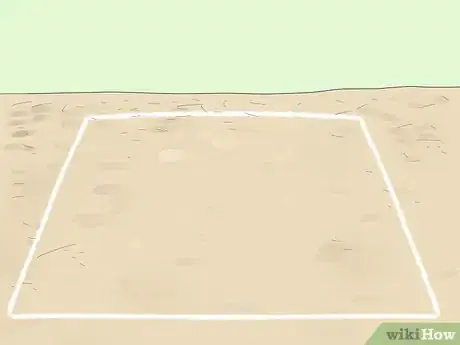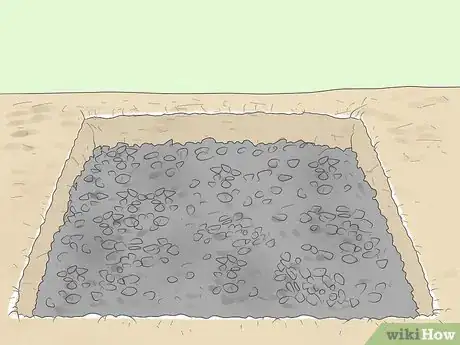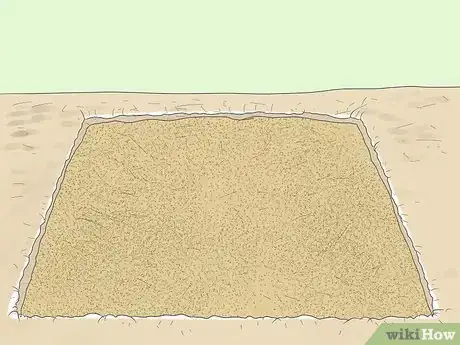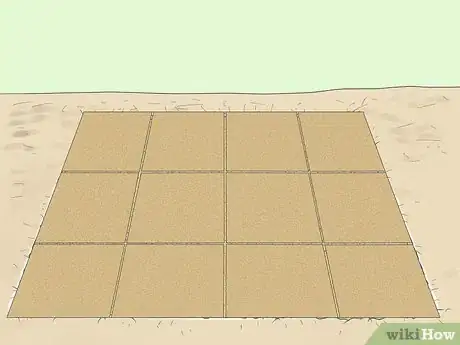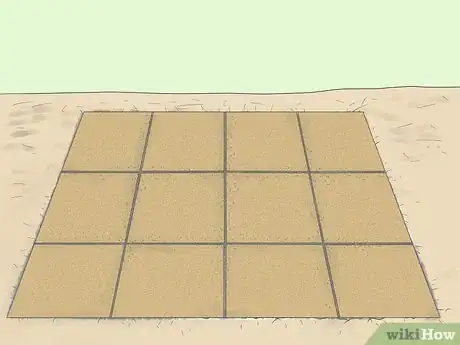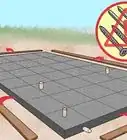This article was co-authored by Grant Wallace. Grant Wallace is a Landscaper and Owner of Grantlanta Lawn in Atlanta, Georgia. With over seven years of experience, he specializes in lawn maintenance and landscape installation. In 2012, he earned his BA from the University of West Georgia. Grant has been profiled in Shoutout Atlanta, Canvas Rebel, and Voyage ATL.
This article has been viewed 107,454 times.
A slab is a structural element used for flooring (similar to tiles but larger in size and usually made of concrete instead of ceramic). You can lay slabs for paving hard surfaces on sidewalks, entrances, patios and more. While the types of slabs available vary greatly, the principles and methods of laying slabs remain largely the same.
Steps
-
1Draw out your project using a pencil, chalk or can of spray-paint depending on the type of surface that you are working on.[1] The layout of the project should be drawn on-location with exact measurements.
-
2Select your slabs.[2] You can choose from a large variety of patterns, colors and surface textures. You also need to decide the thickness of the slabs that you want to use and the material they are made of since this will affect their durability. Slabs for outdoor driveways and sidewalks are 6 to 8 inches (15 to 20 cm) thick whereas the slabs used for indoor porches and garages are 4 to 5 inches (10 to 12.5 cm) thick.Advertisement
-
3Dig out the ground that will be beneath the slabs. This is known as the sub-grade layer and should be the same depth as the combined thickness of the slabs, the sub-base layer, the bedding and the layering.[3]
-
4Fill the base of the sub-grade layer with gravel or limestone. This will create the sub-base layer that should be at least 4 inches (10.2 cm) thick.[4]
-
5Pour construction sand on top of the sub-base layer to make the bedding layer.[5] This will fill gaps in the sub-base layer and also give a smoother surface since the construction sand is finer than the gravel or limestone under it. Pat the construction sand to make it compact and level it to create a fine and smooth surface. The final depth of the bedding layer should be approximately 2 inches (5.1 cm).
-
6Install the leveling layer. The leveling layer needs to be installed with great precision because the slabs will be placed directly on top of it. If the leveling layer is installed incorrectly the slabs may wobble, which will not only make them difficult to walk on but also cause damage to the slabs. You can install a leveling layer successfully using the following steps.
- Use fine sand to create a smoother surface.
- Pour the leveling sand slowly so it has enough time to spread evenly.
- Shape the leveling layer so it is slightly concave. If the slab rests at the edges it will not wobble whereas any bumps near its center point underneath will cause wobbling.
- Make the leveling layer approximately 1 inch (2.5 cm) thick to create the concave shape without exposing any of the bedding layer underneath.
- Do not compact the leveling layer. It is better to leave this layer soft so it can adjust easily as a sort of padding under the slabs.
-
7Lay slabs gently and evenly over the leveling layer to create the final paving. You may need a partner for laying slabs evenly so you can lift each slab from the edges and lower it together while keeping it as flat as possible.
-
8Sweep jointing sand into the gaps between the slabs. This locks the slabs together and prevents them from bumping into each other.
Community Q&A
-
QuestionI laid a limestone step incorrectly, and it's not level. How do I fix the problem? How can I remove the limestone step to reinstall it level or can I add something to the step that'll make it level?
 Community AnswerNope, nothing to add. If you want it right and permanently so, then you'll have to remove it and re-level and re-tamp your base material. It won't ever be right if the base material isn't right, it'll continue to slip, slide, and sink further out of level, since the weight won't be evenly distributed.
Community AnswerNope, nothing to add. If you want it right and permanently so, then you'll have to remove it and re-level and re-tamp your base material. It won't ever be right if the base material isn't right, it'll continue to slip, slide, and sink further out of level, since the weight won't be evenly distributed. -
QuestionMy builder laid down slabs on my patio but I reckon it's all wrong. On 80% of the patio there is a concrete bed & the rest is soil. He put 150mm deep mortar mix and then slabs. Will my patio crumble?
 Brett GilbertTop AnswererIt can cause problems, especially if the concrete experiences a lot of traffic. The mortar mix will move and shift, which can cause it to crack. If your soil is stable and even, then you might not notice any problems with the finished product. Having a base layer, such as gravel and sand, never hurts, though.
Brett GilbertTop AnswererIt can cause problems, especially if the concrete experiences a lot of traffic. The mortar mix will move and shift, which can cause it to crack. If your soil is stable and even, then you might not notice any problems with the finished product. Having a base layer, such as gravel and sand, never hurts, though.
Things You'll Need
- Slabs
- Pencil, chalk or spray-paint
- Gravel or limestone
- Construction sand
- Jointing sand
- Measuring tape
References
- ↑ https://www.homedepot.com/c/ah/how-to-install-patio-pavers/9ba683603be9fa5395fab900ba8276e
- ↑ https://www.todayshomeowner.com/video/patio-pavers/
- ↑ https://www.thisoldhouse.com/how-to/how-to-lay-stone-patio
- ↑ https://www.homedepot.com/c/ah/how-to-install-patio-pavers/9ba683603be9fa5395fab900ba8276e
- ↑ https://www.todayshomeowner.com/video/patio-pavers/
- http://www.intergardening.co.uk/features/surfaces/materials/slabs-tiles/lay-slabs.html
